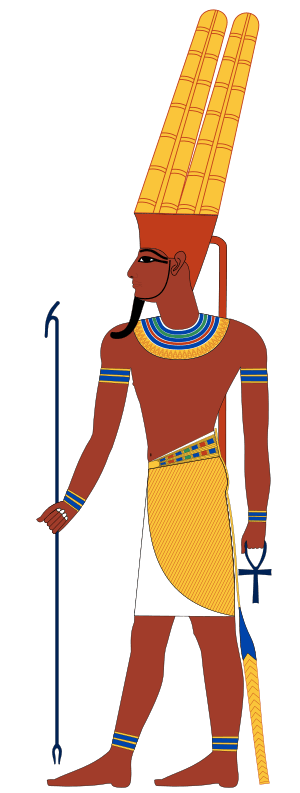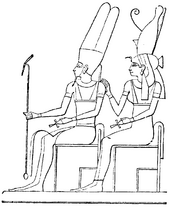Amun facts for kids
Amun was one of the eight ancient Egyptian gods who formed the Ogdoad of Hermopolis. He was the god of the air and his consort was Ament (Amaunet).
In Egyptian mythology, Amun was a very powerful god. He was often combined with Ra to form the god Amun-Ra. At one point in Egyptian history, he was called the "King of the Gods".
Amun (also spelled Amon, Amoun, Amen, and sometimes Imen, Egyptian Yamanu) was the name of a deity, in Egyptian mythology, who became one of the most important deities in Ancient Egypt. In later years, bined with Horus into one god.
He began as a Theban wind and fertility god and ended up the supreme deity, with most of Egypt's vast wealth dedicated to his temple. Around the second millennium B.C.E., Thebes and its cult of Amun grew so powerful that it threatened worship of the sun god, Ra. The two deities merged. Amun-Ra was hailed as a national god, the creator of the universe, the pharaoh's personal protector, and the god of war.
Contents
Origin of name
Amun's name is first recorded as imn. That means "The hidden (one)". Vowels were not written in Egyptian hieroglyphics, but Egyptologists think the name survives into the Coptic language as Amoun.
Creator
It was thought that he had created himself and then created everything else while remaining distant from the rest of the world. In that sense, he was the original inscrutable and indivisible creator.
Amun was shown in human form, seated on a throne, wearing on his head a plain deep circlet from which rise two straight parallel plumes, maybe meant as had no father
When Amun had become more important than Menthu, the local war god of Thebes, Menthu was called the son of Amun. However, as Mut was infertile, it was believed that she, and thus Amun, had adopted Menthu instead.
- David Klotz, Adoration of the Ram: five hymns to Amun-Re from Hibis Temple (New Haven, 2006therwebAnint gypt: th Myth Clasical Dictionary:
Images for kids
-
Statue of Ramesses II with Amun and Mut at the Museo Egizio of Turin, Italy
-
Amon-Ra (l'esprit des quatre elements, lame du monde matérial), N372.2., Brooklyn Museum
-
Bas-relief depicting Amun as pharaoh
-
This Third Intermediate Period amulet from the Walters Art Museum depicts Amun fused with the solar deity, Re, thereby making the supreme solar deity Amun-Re.
See also
 In Spanish: Amón para niños
In Spanish: Amón para niños











